Analysis of Negligence and Misrepresentation in Business Law
VerifiedAdded on 2020/02/23
|8
|2481
|36
Report
AI Summary
This report provides a comprehensive overview of negligence and misrepresentation within the context of business law. It defines negligence as a failure to exercise adequate care, leading to potential civil suits, and misrepresentation as the provision of false information that induces a contract. The report outlines the essential steps involved in establishing both negligence and misrepresentation, including the duty of care, breach of that duty, and causation of harm. It offers practical examples of how these concepts apply to businesses, such as retailers and advisors. The report also explores various defenses against negligence claims, including contributory and comparative negligence, and the assumption of danger. Furthermore, the report examines relevant case laws, such as Stokes v House With No Steps and the Stella Liebeck v McDonald’s Restaurants case, illustrating the practical application of these legal principles. The analysis extends to the concept of public authority negligence and the application of policy/operation distinction. Finally, the report outlines the remedies for negligence and misrepresentation, emphasizing the recovery of damages, and discusses other business torts. This report is a valuable resource for understanding the legal obligations and potential liabilities of businesses.
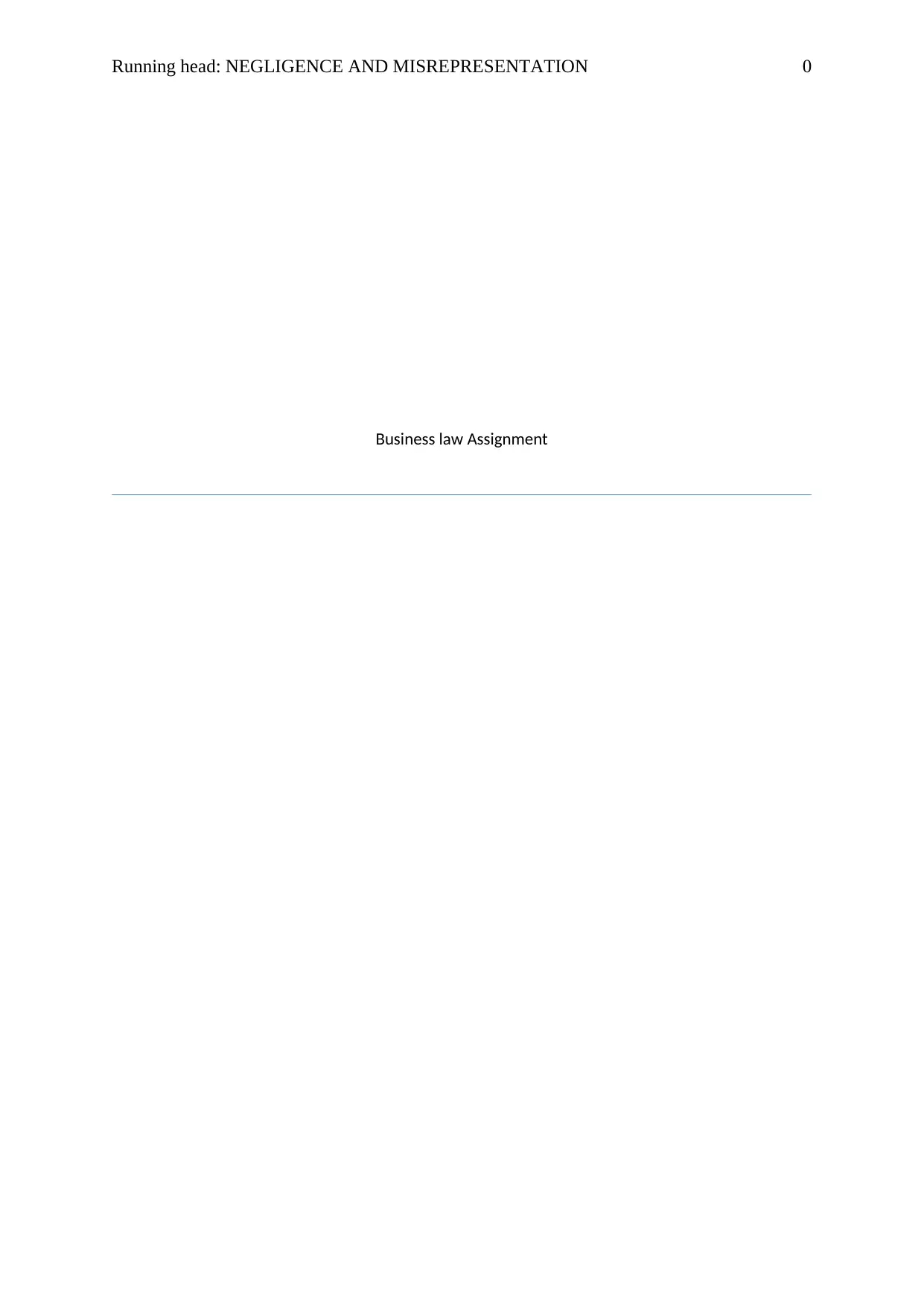
Running head: NEGLIGENCE AND MISREPRESENTATION 0
Business law Assignment
Business law Assignment
Paraphrase This Document
Need a fresh take? Get an instant paraphrase of this document with our AI Paraphraser
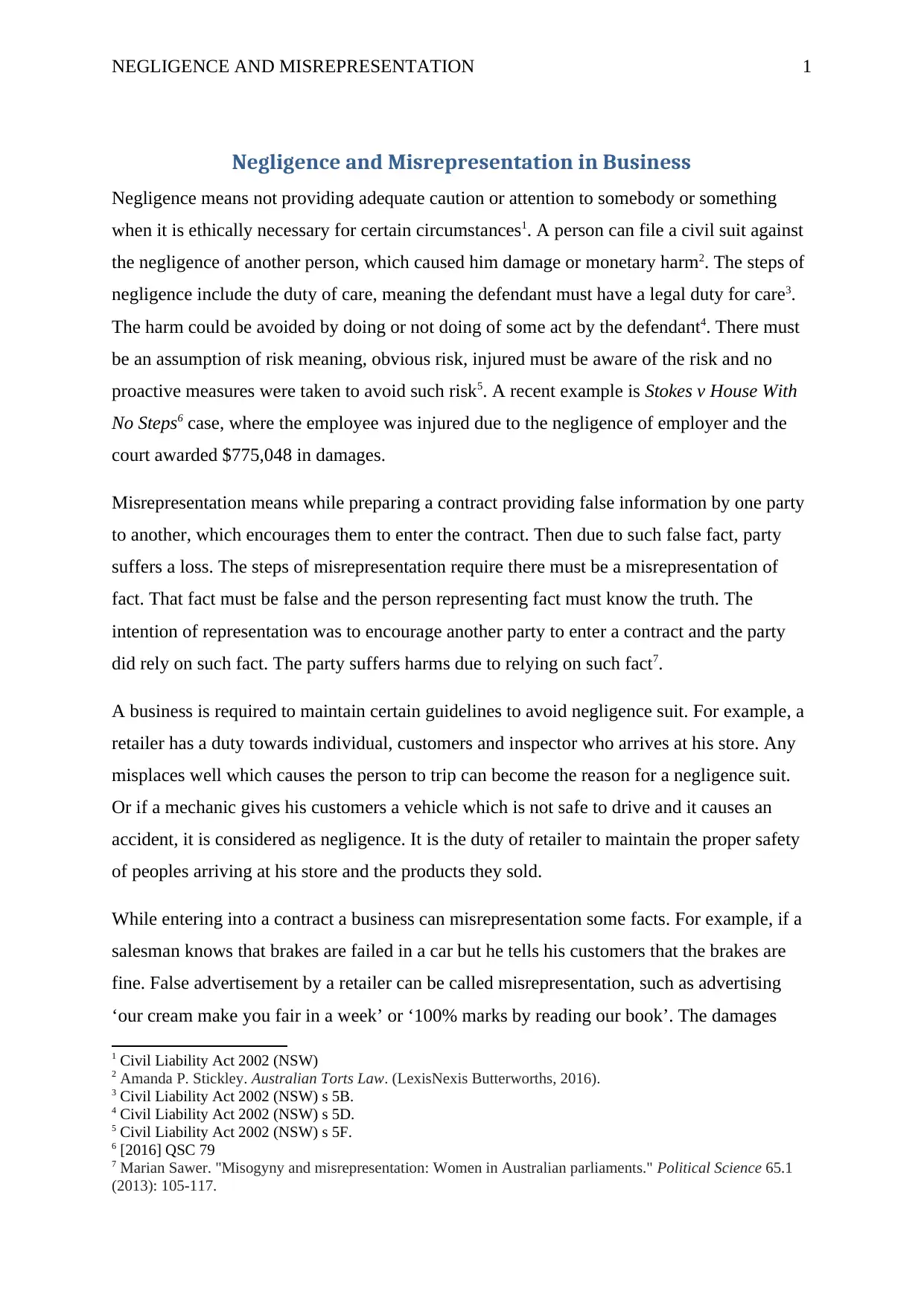
NEGLIGENCE AND MISREPRESENTATION 1
Negligence and Misrepresentation in Business
Negligence means not providing adequate caution or attention to somebody or something
when it is ethically necessary for certain circumstances1. A person can file a civil suit against
the negligence of another person, which caused him damage or monetary harm2. The steps of
negligence include the duty of care, meaning the defendant must have a legal duty for care3.
The harm could be avoided by doing or not doing of some act by the defendant4. There must
be an assumption of risk meaning, obvious risk, injured must be aware of the risk and no
proactive measures were taken to avoid such risk5. A recent example is Stokes v House With
No Steps6 case, where the employee was injured due to the negligence of employer and the
court awarded $775,048 in damages.
Misrepresentation means while preparing a contract providing false information by one party
to another, which encourages them to enter the contract. Then due to such false fact, party
suffers a loss. The steps of misrepresentation require there must be a misrepresentation of
fact. That fact must be false and the person representing fact must know the truth. The
intention of representation was to encourage another party to enter a contract and the party
did rely on such fact. The party suffers harms due to relying on such fact7.
A business is required to maintain certain guidelines to avoid negligence suit. For example, a
retailer has a duty towards individual, customers and inspector who arrives at his store. Any
misplaces well which causes the person to trip can become the reason for a negligence suit.
Or if a mechanic gives his customers a vehicle which is not safe to drive and it causes an
accident, it is considered as negligence. It is the duty of retailer to maintain the proper safety
of peoples arriving at his store and the products they sold.
While entering into a contract a business can misrepresentation some facts. For example, if a
salesman knows that brakes are failed in a car but he tells his customers that the brakes are
fine. False advertisement by a retailer can be called misrepresentation, such as advertising
‘our cream make you fair in a week’ or ‘100% marks by reading our book’. The damages
1 Civil Liability Act 2002 (NSW)
2 Amanda P. Stickley. Australian Torts Law. (LexisNexis Butterworths, 2016).
3 Civil Liability Act 2002 (NSW) s 5B.
4 Civil Liability Act 2002 (NSW) s 5D.
5 Civil Liability Act 2002 (NSW) s 5F.
6 [2016] QSC 79
7 Marian Sawer. "Misogyny and misrepresentation: Women in Australian parliaments." Political Science 65.1
(2013): 105-117.
Negligence and Misrepresentation in Business
Negligence means not providing adequate caution or attention to somebody or something
when it is ethically necessary for certain circumstances1. A person can file a civil suit against
the negligence of another person, which caused him damage or monetary harm2. The steps of
negligence include the duty of care, meaning the defendant must have a legal duty for care3.
The harm could be avoided by doing or not doing of some act by the defendant4. There must
be an assumption of risk meaning, obvious risk, injured must be aware of the risk and no
proactive measures were taken to avoid such risk5. A recent example is Stokes v House With
No Steps6 case, where the employee was injured due to the negligence of employer and the
court awarded $775,048 in damages.
Misrepresentation means while preparing a contract providing false information by one party
to another, which encourages them to enter the contract. Then due to such false fact, party
suffers a loss. The steps of misrepresentation require there must be a misrepresentation of
fact. That fact must be false and the person representing fact must know the truth. The
intention of representation was to encourage another party to enter a contract and the party
did rely on such fact. The party suffers harms due to relying on such fact7.
A business is required to maintain certain guidelines to avoid negligence suit. For example, a
retailer has a duty towards individual, customers and inspector who arrives at his store. Any
misplaces well which causes the person to trip can become the reason for a negligence suit.
Or if a mechanic gives his customers a vehicle which is not safe to drive and it causes an
accident, it is considered as negligence. It is the duty of retailer to maintain the proper safety
of peoples arriving at his store and the products they sold.
While entering into a contract a business can misrepresentation some facts. For example, if a
salesman knows that brakes are failed in a car but he tells his customers that the brakes are
fine. False advertisement by a retailer can be called misrepresentation, such as advertising
‘our cream make you fair in a week’ or ‘100% marks by reading our book’. The damages
1 Civil Liability Act 2002 (NSW)
2 Amanda P. Stickley. Australian Torts Law. (LexisNexis Butterworths, 2016).
3 Civil Liability Act 2002 (NSW) s 5B.
4 Civil Liability Act 2002 (NSW) s 5D.
5 Civil Liability Act 2002 (NSW) s 5F.
6 [2016] QSC 79
7 Marian Sawer. "Misogyny and misrepresentation: Women in Australian parliaments." Political Science 65.1
(2013): 105-117.
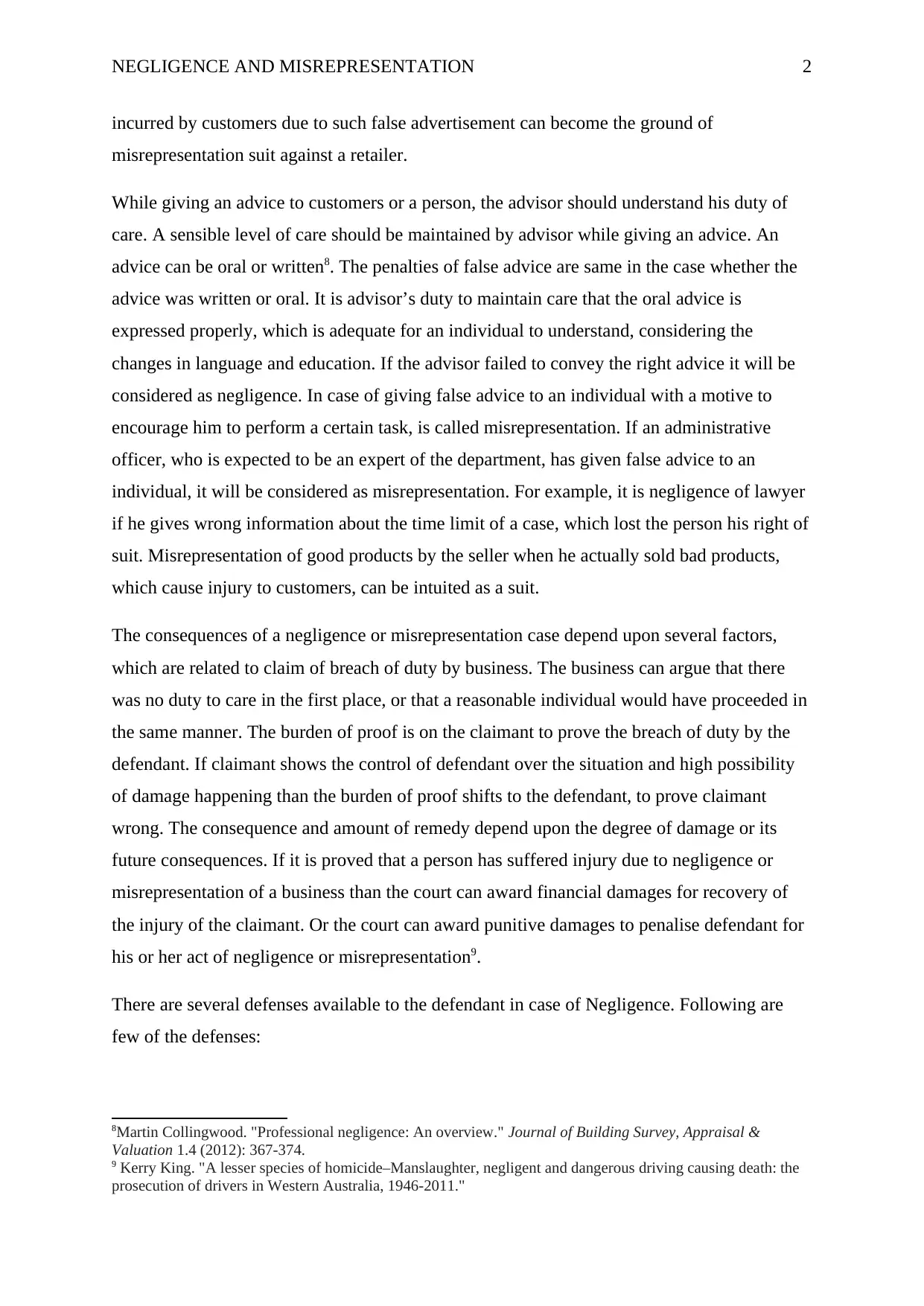
NEGLIGENCE AND MISREPRESENTATION 2
incurred by customers due to such false advertisement can become the ground of
misrepresentation suit against a retailer.
While giving an advice to customers or a person, the advisor should understand his duty of
care. A sensible level of care should be maintained by advisor while giving an advice. An
advice can be oral or written8. The penalties of false advice are same in the case whether the
advice was written or oral. It is advisor’s duty to maintain care that the oral advice is
expressed properly, which is adequate for an individual to understand, considering the
changes in language and education. If the advisor failed to convey the right advice it will be
considered as negligence. In case of giving false advice to an individual with a motive to
encourage him to perform a certain task, is called misrepresentation. If an administrative
officer, who is expected to be an expert of the department, has given false advice to an
individual, it will be considered as misrepresentation. For example, it is negligence of lawyer
if he gives wrong information about the time limit of a case, which lost the person his right of
suit. Misrepresentation of good products by the seller when he actually sold bad products,
which cause injury to customers, can be intuited as a suit.
The consequences of a negligence or misrepresentation case depend upon several factors,
which are related to claim of breach of duty by business. The business can argue that there
was no duty to care in the first place, or that a reasonable individual would have proceeded in
the same manner. The burden of proof is on the claimant to prove the breach of duty by the
defendant. If claimant shows the control of defendant over the situation and high possibility
of damage happening than the burden of proof shifts to the defendant, to prove claimant
wrong. The consequence and amount of remedy depend upon the degree of damage or its
future consequences. If it is proved that a person has suffered injury due to negligence or
misrepresentation of a business than the court can award financial damages for recovery of
the injury of the claimant. Or the court can award punitive damages to penalise defendant for
his or her act of negligence or misrepresentation9.
There are several defenses available to the defendant in case of Negligence. Following are
few of the defenses:
8Martin Collingwood. "Professional negligence: An overview." Journal of Building Survey, Appraisal &
Valuation 1.4 (2012): 367-374.
9 Kerry King. "A lesser species of homicide–Manslaughter, negligent and dangerous driving causing death: the
prosecution of drivers in Western Australia, 1946-2011."
incurred by customers due to such false advertisement can become the ground of
misrepresentation suit against a retailer.
While giving an advice to customers or a person, the advisor should understand his duty of
care. A sensible level of care should be maintained by advisor while giving an advice. An
advice can be oral or written8. The penalties of false advice are same in the case whether the
advice was written or oral. It is advisor’s duty to maintain care that the oral advice is
expressed properly, which is adequate for an individual to understand, considering the
changes in language and education. If the advisor failed to convey the right advice it will be
considered as negligence. In case of giving false advice to an individual with a motive to
encourage him to perform a certain task, is called misrepresentation. If an administrative
officer, who is expected to be an expert of the department, has given false advice to an
individual, it will be considered as misrepresentation. For example, it is negligence of lawyer
if he gives wrong information about the time limit of a case, which lost the person his right of
suit. Misrepresentation of good products by the seller when he actually sold bad products,
which cause injury to customers, can be intuited as a suit.
The consequences of a negligence or misrepresentation case depend upon several factors,
which are related to claim of breach of duty by business. The business can argue that there
was no duty to care in the first place, or that a reasonable individual would have proceeded in
the same manner. The burden of proof is on the claimant to prove the breach of duty by the
defendant. If claimant shows the control of defendant over the situation and high possibility
of damage happening than the burden of proof shifts to the defendant, to prove claimant
wrong. The consequence and amount of remedy depend upon the degree of damage or its
future consequences. If it is proved that a person has suffered injury due to negligence or
misrepresentation of a business than the court can award financial damages for recovery of
the injury of the claimant. Or the court can award punitive damages to penalise defendant for
his or her act of negligence or misrepresentation9.
There are several defenses available to the defendant in case of Negligence. Following are
few of the defenses:
8Martin Collingwood. "Professional negligence: An overview." Journal of Building Survey, Appraisal &
Valuation 1.4 (2012): 367-374.
9 Kerry King. "A lesser species of homicide–Manslaughter, negligent and dangerous driving causing death: the
prosecution of drivers in Western Australia, 1946-2011."
⊘ This is a preview!⊘
Do you want full access?
Subscribe today to unlock all pages.

Trusted by 1+ million students worldwide
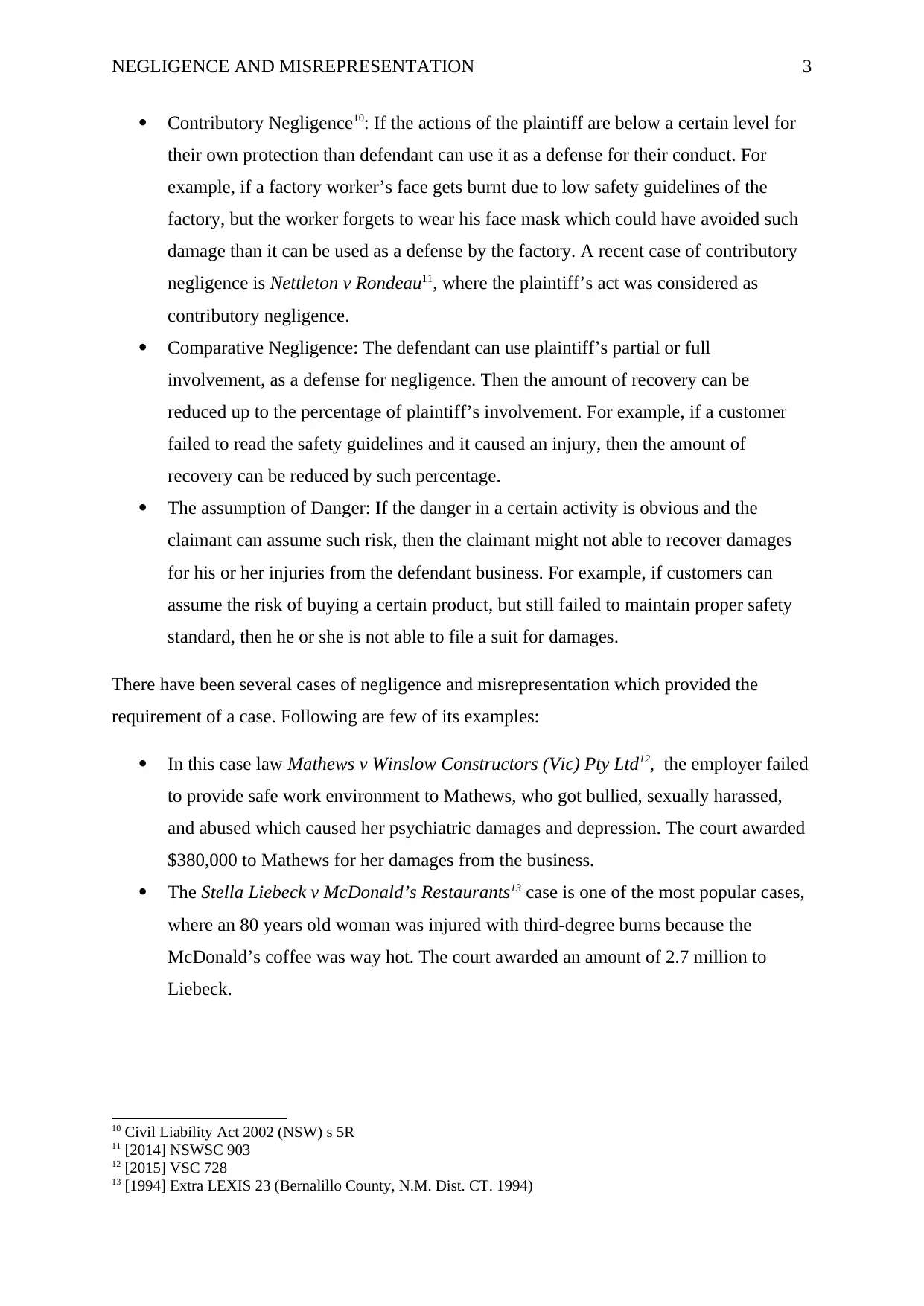
NEGLIGENCE AND MISREPRESENTATION 3
Contributory Negligence10: If the actions of the plaintiff are below a certain level for
their own protection than defendant can use it as a defense for their conduct. For
example, if a factory worker’s face gets burnt due to low safety guidelines of the
factory, but the worker forgets to wear his face mask which could have avoided such
damage than it can be used as a defense by the factory. A recent case of contributory
negligence is Nettleton v Rondeau11, where the plaintiff’s act was considered as
contributory negligence.
Comparative Negligence: The defendant can use plaintiff’s partial or full
involvement, as a defense for negligence. Then the amount of recovery can be
reduced up to the percentage of plaintiff’s involvement. For example, if a customer
failed to read the safety guidelines and it caused an injury, then the amount of
recovery can be reduced by such percentage.
The assumption of Danger: If the danger in a certain activity is obvious and the
claimant can assume such risk, then the claimant might not able to recover damages
for his or her injuries from the defendant business. For example, if customers can
assume the risk of buying a certain product, but still failed to maintain proper safety
standard, then he or she is not able to file a suit for damages.
There have been several cases of negligence and misrepresentation which provided the
requirement of a case. Following are few of its examples:
In this case law Mathews v Winslow Constructors (Vic) Pty Ltd12, the employer failed
to provide safe work environment to Mathews, who got bullied, sexually harassed,
and abused which caused her psychiatric damages and depression. The court awarded
$380,000 to Mathews for her damages from the business.
The Stella Liebeck v McDonald’s Restaurants13 case is one of the most popular cases,
where an 80 years old woman was injured with third-degree burns because the
McDonald’s coffee was way hot. The court awarded an amount of 2.7 million to
Liebeck.
10 Civil Liability Act 2002 (NSW) s 5R
11 [2014] NSWSC 903
12 [2015] VSC 728
13 [1994] Extra LEXIS 23 (Bernalillo County, N.M. Dist. CT. 1994)
Contributory Negligence10: If the actions of the plaintiff are below a certain level for
their own protection than defendant can use it as a defense for their conduct. For
example, if a factory worker’s face gets burnt due to low safety guidelines of the
factory, but the worker forgets to wear his face mask which could have avoided such
damage than it can be used as a defense by the factory. A recent case of contributory
negligence is Nettleton v Rondeau11, where the plaintiff’s act was considered as
contributory negligence.
Comparative Negligence: The defendant can use plaintiff’s partial or full
involvement, as a defense for negligence. Then the amount of recovery can be
reduced up to the percentage of plaintiff’s involvement. For example, if a customer
failed to read the safety guidelines and it caused an injury, then the amount of
recovery can be reduced by such percentage.
The assumption of Danger: If the danger in a certain activity is obvious and the
claimant can assume such risk, then the claimant might not able to recover damages
for his or her injuries from the defendant business. For example, if customers can
assume the risk of buying a certain product, but still failed to maintain proper safety
standard, then he or she is not able to file a suit for damages.
There have been several cases of negligence and misrepresentation which provided the
requirement of a case. Following are few of its examples:
In this case law Mathews v Winslow Constructors (Vic) Pty Ltd12, the employer failed
to provide safe work environment to Mathews, who got bullied, sexually harassed,
and abused which caused her psychiatric damages and depression. The court awarded
$380,000 to Mathews for her damages from the business.
The Stella Liebeck v McDonald’s Restaurants13 case is one of the most popular cases,
where an 80 years old woman was injured with third-degree burns because the
McDonald’s coffee was way hot. The court awarded an amount of 2.7 million to
Liebeck.
10 Civil Liability Act 2002 (NSW) s 5R
11 [2014] NSWSC 903
12 [2015] VSC 728
13 [1994] Extra LEXIS 23 (Bernalillo County, N.M. Dist. CT. 1994)
Paraphrase This Document
Need a fresh take? Get an instant paraphrase of this document with our AI Paraphraser
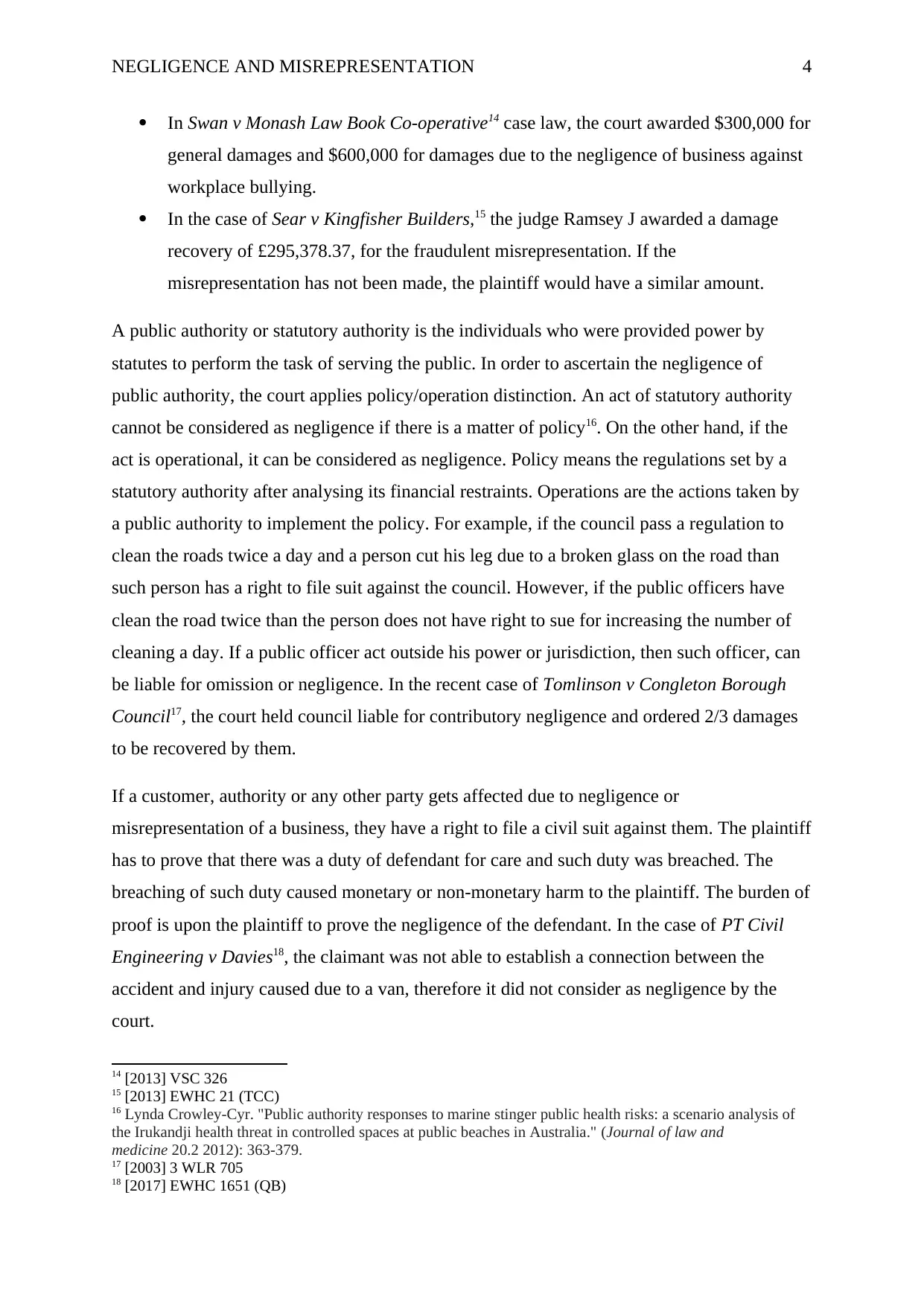
NEGLIGENCE AND MISREPRESENTATION 4
In Swan v Monash Law Book Co-operative14 case law, the court awarded $300,000 for
general damages and $600,000 for damages due to the negligence of business against
workplace bullying.
In the case of Sear v Kingfisher Builders,15 the judge Ramsey J awarded a damage
recovery of £295,378.37, for the fraudulent misrepresentation. If the
misrepresentation has not been made, the plaintiff would have a similar amount.
A public authority or statutory authority is the individuals who were provided power by
statutes to perform the task of serving the public. In order to ascertain the negligence of
public authority, the court applies policy/operation distinction. An act of statutory authority
cannot be considered as negligence if there is a matter of policy16. On the other hand, if the
act is operational, it can be considered as negligence. Policy means the regulations set by a
statutory authority after analysing its financial restraints. Operations are the actions taken by
a public authority to implement the policy. For example, if the council pass a regulation to
clean the roads twice a day and a person cut his leg due to a broken glass on the road than
such person has a right to file suit against the council. However, if the public officers have
clean the road twice than the person does not have right to sue for increasing the number of
cleaning a day. If a public officer act outside his power or jurisdiction, then such officer, can
be liable for omission or negligence. In the recent case of Tomlinson v Congleton Borough
Council17, the court held council liable for contributory negligence and ordered 2/3 damages
to be recovered by them.
If a customer, authority or any other party gets affected due to negligence or
misrepresentation of a business, they have a right to file a civil suit against them. The plaintiff
has to prove that there was a duty of defendant for care and such duty was breached. The
breaching of such duty caused monetary or non-monetary harm to the plaintiff. The burden of
proof is upon the plaintiff to prove the negligence of the defendant. In the case of PT Civil
Engineering v Davies18, the claimant was not able to establish a connection between the
accident and injury caused due to a van, therefore it did not consider as negligence by the
court.
14 [2013] VSC 326
15 [2013] EWHC 21 (TCC)
16 Lynda Crowley-Cyr. "Public authority responses to marine stinger public health risks: a scenario analysis of
the Irukandji health threat in controlled spaces at public beaches in Australia." (Journal of law and
medicine 20.2 2012): 363-379.
17 [2003] 3 WLR 705
18 [2017] EWHC 1651 (QB)
In Swan v Monash Law Book Co-operative14 case law, the court awarded $300,000 for
general damages and $600,000 for damages due to the negligence of business against
workplace bullying.
In the case of Sear v Kingfisher Builders,15 the judge Ramsey J awarded a damage
recovery of £295,378.37, for the fraudulent misrepresentation. If the
misrepresentation has not been made, the plaintiff would have a similar amount.
A public authority or statutory authority is the individuals who were provided power by
statutes to perform the task of serving the public. In order to ascertain the negligence of
public authority, the court applies policy/operation distinction. An act of statutory authority
cannot be considered as negligence if there is a matter of policy16. On the other hand, if the
act is operational, it can be considered as negligence. Policy means the regulations set by a
statutory authority after analysing its financial restraints. Operations are the actions taken by
a public authority to implement the policy. For example, if the council pass a regulation to
clean the roads twice a day and a person cut his leg due to a broken glass on the road than
such person has a right to file suit against the council. However, if the public officers have
clean the road twice than the person does not have right to sue for increasing the number of
cleaning a day. If a public officer act outside his power or jurisdiction, then such officer, can
be liable for omission or negligence. In the recent case of Tomlinson v Congleton Borough
Council17, the court held council liable for contributory negligence and ordered 2/3 damages
to be recovered by them.
If a customer, authority or any other party gets affected due to negligence or
misrepresentation of a business, they have a right to file a civil suit against them. The plaintiff
has to prove that there was a duty of defendant for care and such duty was breached. The
breaching of such duty caused monetary or non-monetary harm to the plaintiff. The burden of
proof is upon the plaintiff to prove the negligence of the defendant. In the case of PT Civil
Engineering v Davies18, the claimant was not able to establish a connection between the
accident and injury caused due to a van, therefore it did not consider as negligence by the
court.
14 [2013] VSC 326
15 [2013] EWHC 21 (TCC)
16 Lynda Crowley-Cyr. "Public authority responses to marine stinger public health risks: a scenario analysis of
the Irukandji health threat in controlled spaces at public beaches in Australia." (Journal of law and
medicine 20.2 2012): 363-379.
17 [2003] 3 WLR 705
18 [2017] EWHC 1651 (QB)
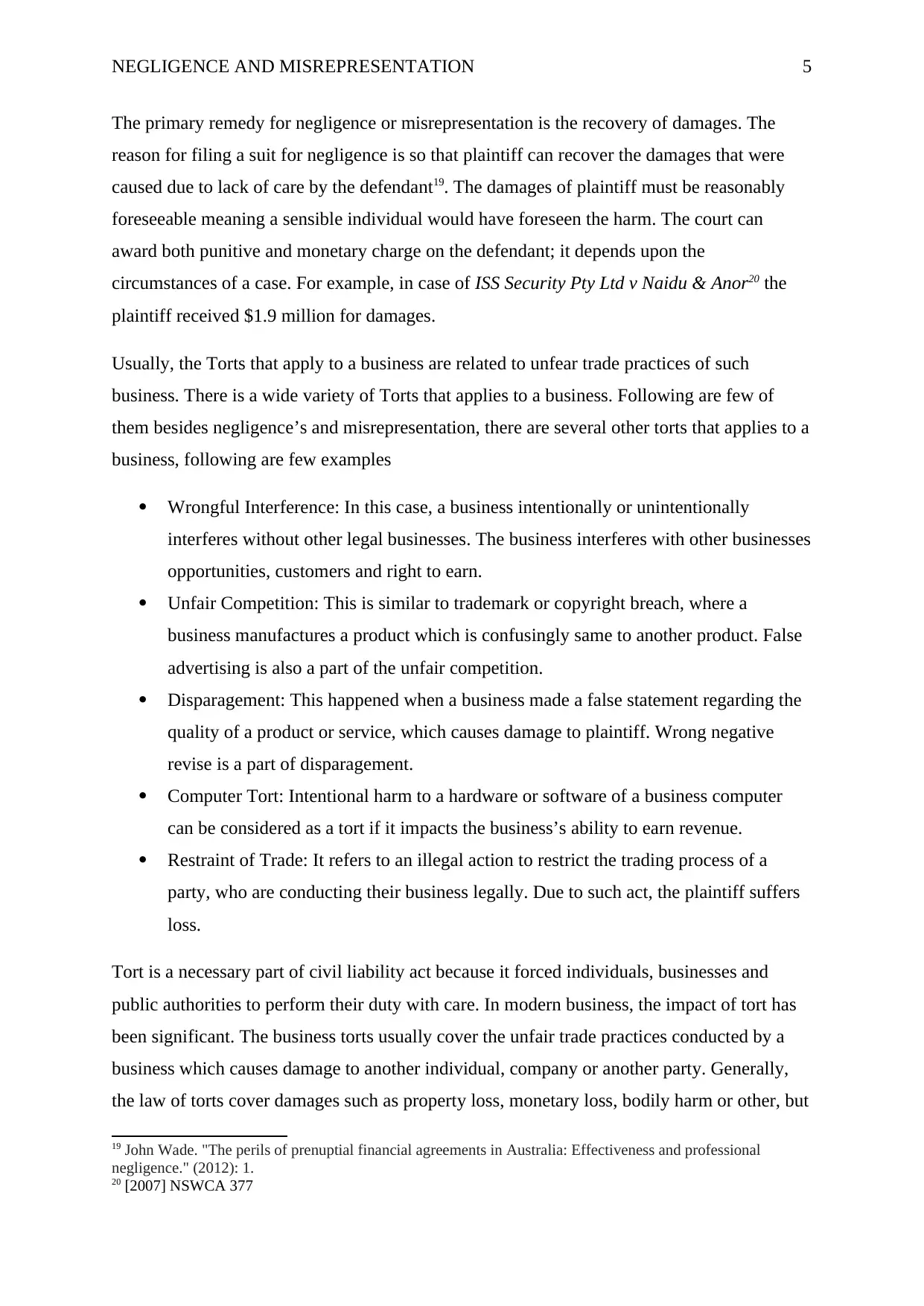
NEGLIGENCE AND MISREPRESENTATION 5
The primary remedy for negligence or misrepresentation is the recovery of damages. The
reason for filing a suit for negligence is so that plaintiff can recover the damages that were
caused due to lack of care by the defendant19. The damages of plaintiff must be reasonably
foreseeable meaning a sensible individual would have foreseen the harm. The court can
award both punitive and monetary charge on the defendant; it depends upon the
circumstances of a case. For example, in case of ISS Security Pty Ltd v Naidu & Anor20 the
plaintiff received $1.9 million for damages.
Usually, the Torts that apply to a business are related to unfear trade practices of such
business. There is a wide variety of Torts that applies to a business. Following are few of
them besides negligence’s and misrepresentation, there are several other torts that applies to a
business, following are few examples
Wrongful Interference: In this case, a business intentionally or unintentionally
interferes without other legal businesses. The business interferes with other businesses
opportunities, customers and right to earn.
Unfair Competition: This is similar to trademark or copyright breach, where a
business manufactures a product which is confusingly same to another product. False
advertising is also a part of the unfair competition.
Disparagement: This happened when a business made a false statement regarding the
quality of a product or service, which causes damage to plaintiff. Wrong negative
revise is a part of disparagement.
Computer Tort: Intentional harm to a hardware or software of a business computer
can be considered as a tort if it impacts the business’s ability to earn revenue.
Restraint of Trade: It refers to an illegal action to restrict the trading process of a
party, who are conducting their business legally. Due to such act, the plaintiff suffers
loss.
Tort is a necessary part of civil liability act because it forced individuals, businesses and
public authorities to perform their duty with care. In modern business, the impact of tort has
been significant. The business torts usually cover the unfair trade practices conducted by a
business which causes damage to another individual, company or another party. Generally,
the law of torts cover damages such as property loss, monetary loss, bodily harm or other, but
19 John Wade. "The perils of prenuptial financial agreements in Australia: Effectiveness and professional
negligence." (2012): 1.
20 [2007] NSWCA 377
The primary remedy for negligence or misrepresentation is the recovery of damages. The
reason for filing a suit for negligence is so that plaintiff can recover the damages that were
caused due to lack of care by the defendant19. The damages of plaintiff must be reasonably
foreseeable meaning a sensible individual would have foreseen the harm. The court can
award both punitive and monetary charge on the defendant; it depends upon the
circumstances of a case. For example, in case of ISS Security Pty Ltd v Naidu & Anor20 the
plaintiff received $1.9 million for damages.
Usually, the Torts that apply to a business are related to unfear trade practices of such
business. There is a wide variety of Torts that applies to a business. Following are few of
them besides negligence’s and misrepresentation, there are several other torts that applies to a
business, following are few examples
Wrongful Interference: In this case, a business intentionally or unintentionally
interferes without other legal businesses. The business interferes with other businesses
opportunities, customers and right to earn.
Unfair Competition: This is similar to trademark or copyright breach, where a
business manufactures a product which is confusingly same to another product. False
advertising is also a part of the unfair competition.
Disparagement: This happened when a business made a false statement regarding the
quality of a product or service, which causes damage to plaintiff. Wrong negative
revise is a part of disparagement.
Computer Tort: Intentional harm to a hardware or software of a business computer
can be considered as a tort if it impacts the business’s ability to earn revenue.
Restraint of Trade: It refers to an illegal action to restrict the trading process of a
party, who are conducting their business legally. Due to such act, the plaintiff suffers
loss.
Tort is a necessary part of civil liability act because it forced individuals, businesses and
public authorities to perform their duty with care. In modern business, the impact of tort has
been significant. The business torts usually cover the unfair trade practices conducted by a
business which causes damage to another individual, company or another party. Generally,
the law of torts cover damages such as property loss, monetary loss, bodily harm or other, but
19 John Wade. "The perils of prenuptial financial agreements in Australia: Effectiveness and professional
negligence." (2012): 1.
20 [2007] NSWCA 377
⊘ This is a preview!⊘
Do you want full access?
Subscribe today to unlock all pages.

Trusted by 1+ million students worldwide
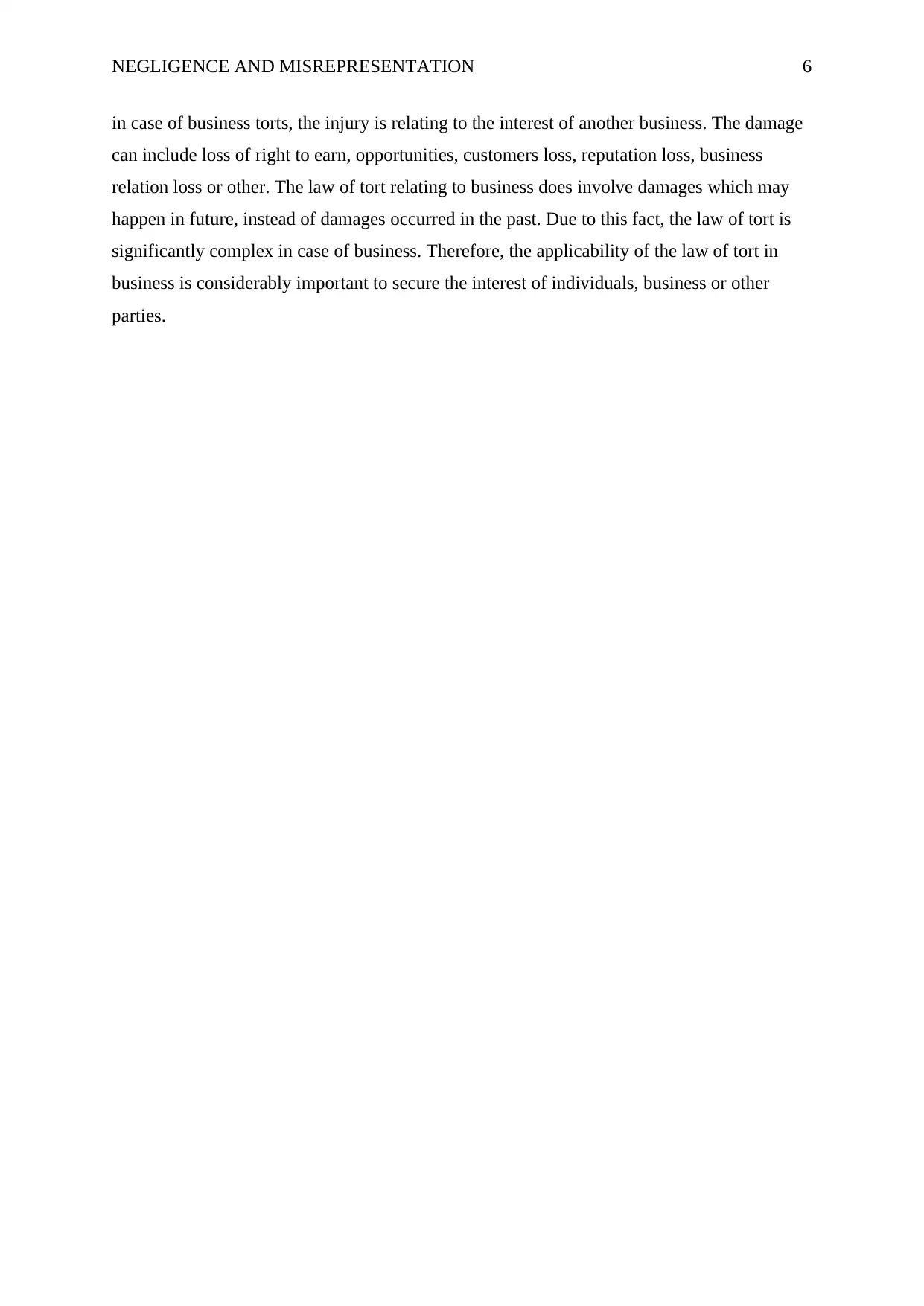
NEGLIGENCE AND MISREPRESENTATION 6
in case of business torts, the injury is relating to the interest of another business. The damage
can include loss of right to earn, opportunities, customers loss, reputation loss, business
relation loss or other. The law of tort relating to business does involve damages which may
happen in future, instead of damages occurred in the past. Due to this fact, the law of tort is
significantly complex in case of business. Therefore, the applicability of the law of tort in
business is considerably important to secure the interest of individuals, business or other
parties.
in case of business torts, the injury is relating to the interest of another business. The damage
can include loss of right to earn, opportunities, customers loss, reputation loss, business
relation loss or other. The law of tort relating to business does involve damages which may
happen in future, instead of damages occurred in the past. Due to this fact, the law of tort is
significantly complex in case of business. Therefore, the applicability of the law of tort in
business is considerably important to secure the interest of individuals, business or other
parties.
Paraphrase This Document
Need a fresh take? Get an instant paraphrase of this document with our AI Paraphraser
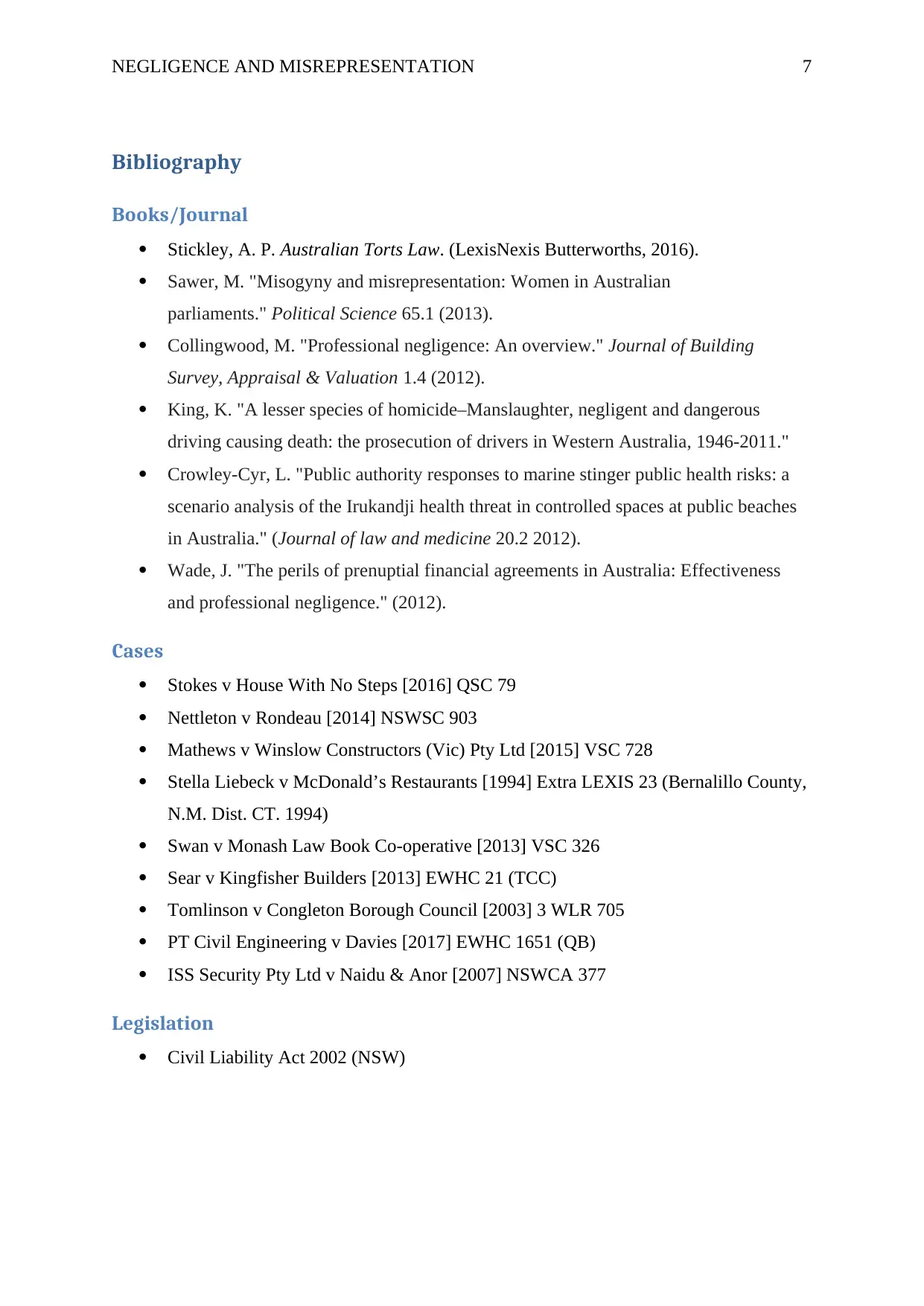
NEGLIGENCE AND MISREPRESENTATION 7
Bibliography
Books/Journal
Stickley, A. P. Australian Torts Law. (LexisNexis Butterworths, 2016).
Sawer, M. "Misogyny and misrepresentation: Women in Australian
parliaments." Political Science 65.1 (2013).
Collingwood, M. "Professional negligence: An overview." Journal of Building
Survey, Appraisal & Valuation 1.4 (2012).
King, K. "A lesser species of homicide–Manslaughter, negligent and dangerous
driving causing death: the prosecution of drivers in Western Australia, 1946-2011."
Crowley-Cyr, L. "Public authority responses to marine stinger public health risks: a
scenario analysis of the Irukandji health threat in controlled spaces at public beaches
in Australia." (Journal of law and medicine 20.2 2012).
Wade, J. "The perils of prenuptial financial agreements in Australia: Effectiveness
and professional negligence." (2012).
Cases
Stokes v House With No Steps [2016] QSC 79
Nettleton v Rondeau [2014] NSWSC 903
Mathews v Winslow Constructors (Vic) Pty Ltd [2015] VSC 728
Stella Liebeck v McDonald’s Restaurants [1994] Extra LEXIS 23 (Bernalillo County,
N.M. Dist. CT. 1994)
Swan v Monash Law Book Co-operative [2013] VSC 326
Sear v Kingfisher Builders [2013] EWHC 21 (TCC)
Tomlinson v Congleton Borough Council [2003] 3 WLR 705
PT Civil Engineering v Davies [2017] EWHC 1651 (QB)
ISS Security Pty Ltd v Naidu & Anor [2007] NSWCA 377
Legislation
Civil Liability Act 2002 (NSW)
Bibliography
Books/Journal
Stickley, A. P. Australian Torts Law. (LexisNexis Butterworths, 2016).
Sawer, M. "Misogyny and misrepresentation: Women in Australian
parliaments." Political Science 65.1 (2013).
Collingwood, M. "Professional negligence: An overview." Journal of Building
Survey, Appraisal & Valuation 1.4 (2012).
King, K. "A lesser species of homicide–Manslaughter, negligent and dangerous
driving causing death: the prosecution of drivers in Western Australia, 1946-2011."
Crowley-Cyr, L. "Public authority responses to marine stinger public health risks: a
scenario analysis of the Irukandji health threat in controlled spaces at public beaches
in Australia." (Journal of law and medicine 20.2 2012).
Wade, J. "The perils of prenuptial financial agreements in Australia: Effectiveness
and professional negligence." (2012).
Cases
Stokes v House With No Steps [2016] QSC 79
Nettleton v Rondeau [2014] NSWSC 903
Mathews v Winslow Constructors (Vic) Pty Ltd [2015] VSC 728
Stella Liebeck v McDonald’s Restaurants [1994] Extra LEXIS 23 (Bernalillo County,
N.M. Dist. CT. 1994)
Swan v Monash Law Book Co-operative [2013] VSC 326
Sear v Kingfisher Builders [2013] EWHC 21 (TCC)
Tomlinson v Congleton Borough Council [2003] 3 WLR 705
PT Civil Engineering v Davies [2017] EWHC 1651 (QB)
ISS Security Pty Ltd v Naidu & Anor [2007] NSWCA 377
Legislation
Civil Liability Act 2002 (NSW)
1 out of 8
Related Documents
Your All-in-One AI-Powered Toolkit for Academic Success.
+13062052269
info@desklib.com
Available 24*7 on WhatsApp / Email
![[object Object]](/_next/static/media/star-bottom.7253800d.svg)
Unlock your academic potential
Copyright © 2020–2025 A2Z Services. All Rights Reserved. Developed and managed by ZUCOL.





